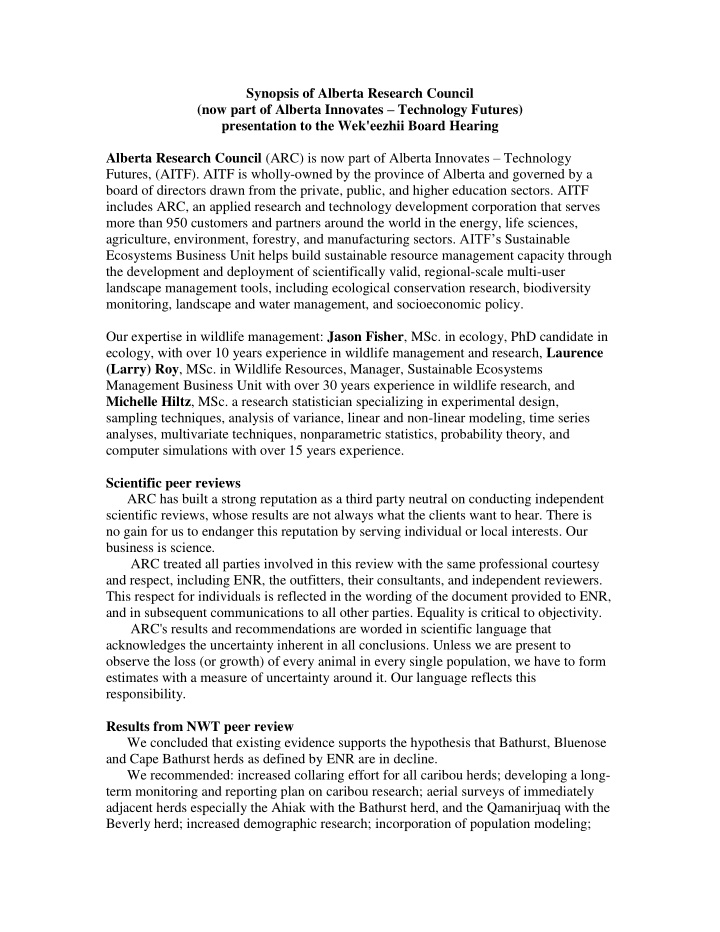



Synopsis of Alberta Research Council (now part of Alberta Innovates – Technology Futures) presentation to the Wek'eezhii Board Hearing Alberta Research Council (ARC) is now part of Alberta Innovates – Technology Futures, (AITF). AITF is wholly-owned by the province of Alberta and governed by a board of directors drawn from the private, public, and higher education sectors. AITF includes ARC, an applied research and technology development corporation that serves more than 950 customers and partners around the world in the energy, life sciences, agriculture, environment, forestry, and manufacturing sectors. AITF’s Sustainable Ecosystems Business Unit helps build sustainable resource management capacity through the development and deployment of scientifically valid, regional-scale multi-user landscape management tools, including ecological conservation research, biodiversity monitoring, landscape and water management, and socioeconomic policy. Our expertise in wildlife management: Jason Fisher , MSc. in ecology, PhD candidate in ecology, with over 10 years experience in wildlife management and research, Laurence (Larry) Roy , MSc. in Wildlife Resources, Manager, Sustainable Ecosystems Management Business Unit with over 30 years experience in wildlife research, and Michelle Hiltz , MSc. a research statistician specializing in experimental design, sampling techniques, analysis of variance, linear and non-linear modeling, time series analyses, multivariate techniques, nonparametric statistics, probability theory, and computer simulations with over 15 years experience. Scientific peer reviews ARC has built a strong reputation as a third party neutral on conducting independent scientific reviews, whose results are not always what the clients want to hear. There is no gain for us to endanger this reputation by serving individual or local interests. Our business is science. ARC treated all parties involved in this review with the same professional courtesy and respect, including ENR, the outfitters, their consultants, and independent reviewers. This respect for individuals is reflected in the wording of the document provided to ENR, and in subsequent communications to all other parties. Equality is critical to objectivity. ARC's results and recommendations are worded in scientific language that acknowledges the uncertainty inherent in all conclusions. Unless we are present to observe the loss (or growth) of every animal in every single population, we have to form estimates with a measure of uncertainty around it. Our language reflects this responsibility. Results from NWT peer review We concluded that existing evidence supports the hypothesis that Bathurst, Bluenose and Cape Bathurst herds as defined by ENR are in decline. We recommended: increased collaring effort for all caribou herds; developing a long- term monitoring and reporting plan on caribou research; aerial surveys of immediately adjacent herds especially the Ahiak with the Bathurst herd, and the Qamanirjuaq with the Beverly herd; increased demographic research; incorporation of population modeling;
provision of peer reviews for all survey reports; immediate open and transparent reporting of results; development of a cross jurisdiction strategic management approach; use of an adaptive management framework; and formation of partnerships to increase resources dedicated to caribou research. Comments on 2009 Calgary Workshop attended by Jason Fisher The 2009 Bathurst survey was the best-designed survey conducted to date, with the most precise estimate. This estimate shows very conclusively that the Bathhurst population as defined by NWT is at much lower numbers than previous years. Population models had been done using classification data and showed that vital rates had dropped significantly in the Bathurst over the last several years, which also provides strong corroborative evidence of a decline. Available telemetry data had been modelled using state-space modelling to determine probabilities of caribou belonging to Bathurst then switching to Ahiak, and vice versa. Both movement rates were low (a few percent). Net movement was from Bathurst to Ahiak but this was extremely low, and not nearly enough to account for the loss of animals from Bathurst observed over the last several years. .
Recommend
More recommend